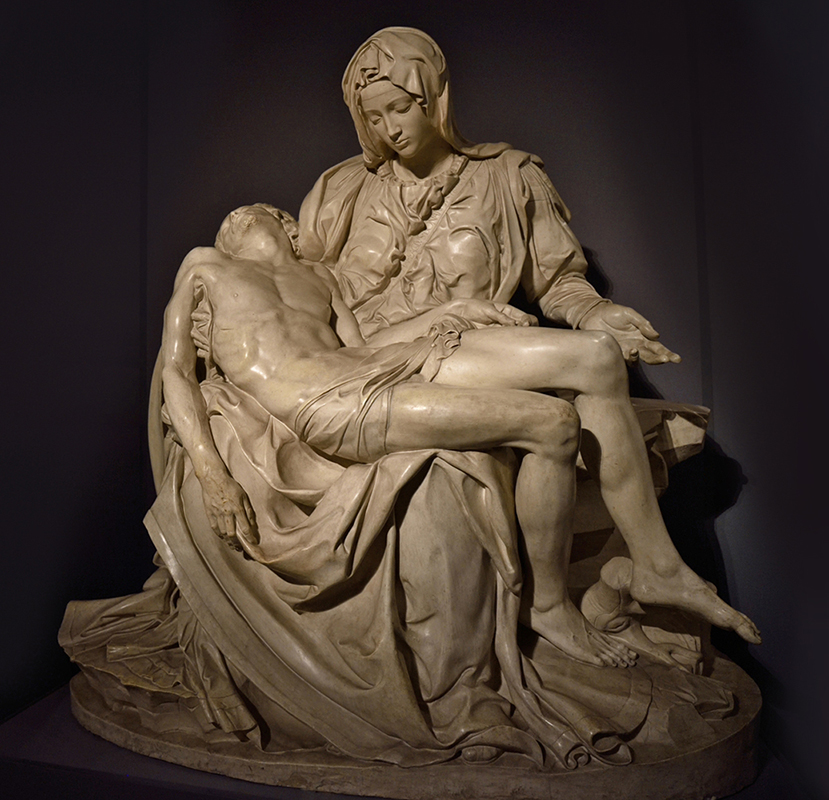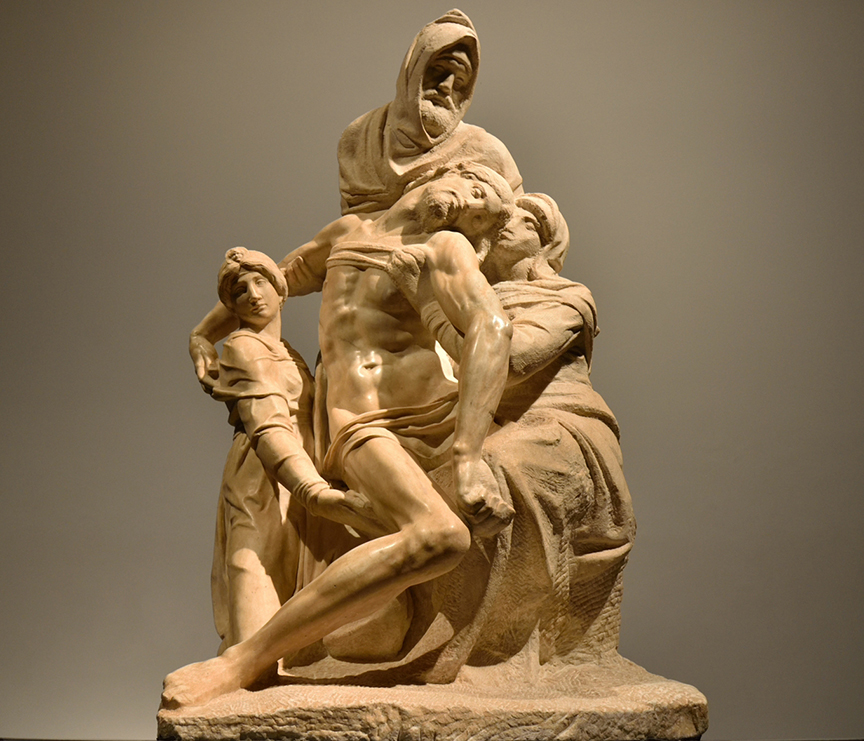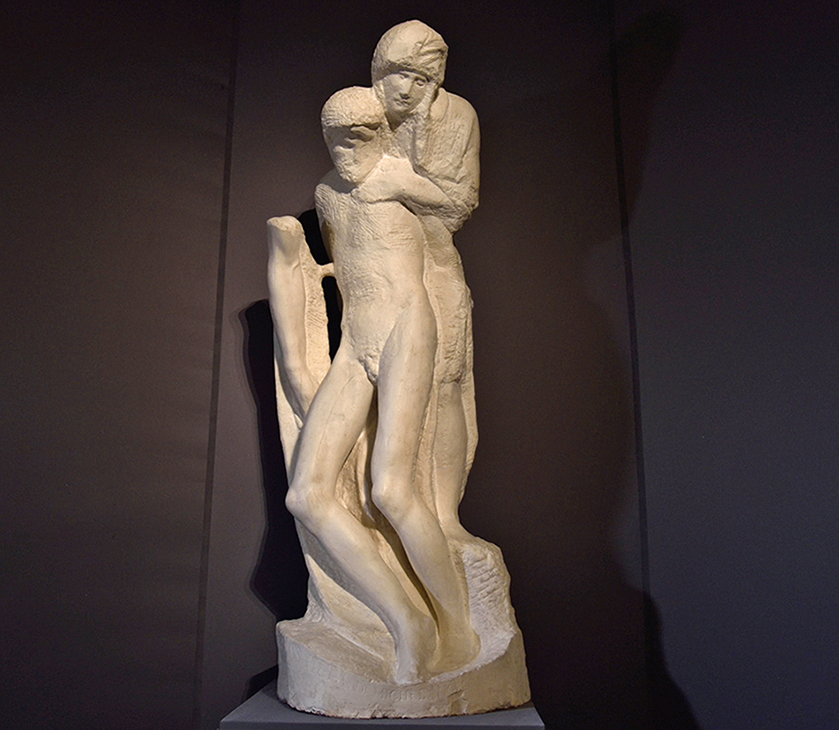Last Words: A Lenten Meditation on the Final Sayings of Christ, Week 4Sample

The Mother of Christ Mourns: The Sword of Grief

Pietà, Michelangelo Buonarroti, 1498–1499. Carrara marble, 174 x 195 cm. Saint Peter’s Basilica, Vatican City, Italy.

The Deposition (The Bandini Pietà), Michelangelo Buonarroti, 1547–1555. Marble, 277 cm. Museo dell’Opera del Duomo, Florence, Italy.

Rondanini Pieta, Michelangelo Buonarroti, 1564. Marble, 185 cm. Castello Sforzesco, Milan, Italy.
“Stabat Mater” Part 1. Composed by Arvo Pärt. Performed by Choir Vox Humana (Oslo) and string ensemble Inter Arcus, conductor Dag Jansson.
Poetry:
“Pieta”
by Rainer Maria Rilke
Fills now my cup, and past thought is
my fulness thereof. I harden as a stone
sets hard at its heart.
Hard that I am, I know this alone:
that thou didst grow—
— — — — — and grow,
to outgrow,
as too great pain,
my heart’s reach utterly.
Now liest thou my womb athwart,
now can I not to thee again
give birth.
THE MOTHER OF CHRIST MOURNS: THE SWORD OF GRIEF
These three pietàs by maestro Michelangelo and the haunting Stabat Mater of 89-year-old Estonian composer Arvo Pärt move us into a contemplative space where words fall far below… and fail.
+++++++
The first time I saw the so-called Bandini Pietà (Deposition) at Museo del Opera del Duomo in Florence, I was thunderstruck. How could any human being master stone carving so completely that inanimate rock itself breathes? My reaction reminded me of the story of Pygmalion and Galatea, where the sculptor enters forbidden territory––praying to the gods that his perfect woman (carved from marble) would come to life. In the myth she awakens and breathes but spurns the artist’s adoration and wants nothing to do with him. A devastating consequence of artistic hubris and ungodly ambition.
Michelangelo––named for the archangel Michael––was indeed bordering on the forbidden in this series of nearly miraculous works of art. In the earliest and most famous Pietà carved when he was in his 20s and living in Rome, the young master carver shows his preternatural capacity for bringing stone to life (and death). Every muscle and sinew vibrant and astonishingly real––both Mother and Son. Jesus’s lifeless body stretched across her lap seems still-warm as though freshly taken down from the cross. Her perpetual virginity (a doctrine of the Roman Church) is figured in her youthful form, but the real thought here is figlia del tuo Figlio––in Italian: daughter of your Son. The mystery that Christ’s mother gave birth to her own creator and God. This is (or should be) still a scandal. The Incarnation is a much wilder theological reality than the Resurrection! The infinite Creator comes to be born, willingly made helpless and dependent upon a fourteen-year-old single human mother.
The Rondanini Pietà—the fruit of the aged Michelangelo and one of his last works also breathes––but the intake of breath seems shallower and the exhalation final. The lack of resolution to the form ought to be set alongside the magisterial pietà from the artist’s early days. Why are the Bandini and the Rondanini partly unresolved? Is it simply that the sculptor never finished them? I think not. They harken back to his earlier captive slave series that all seem intentionally unfinished––bustling with vitality and revealing the hammer blows of the artist. And it is in that very “unfinished” state that these works seem to come to life. Process is everything––and the marks of the chisel are no longer disguised in high polish. The artist seems to say, “This form has made its entry into the world. I can no longer fuss over it but must step aside and let it be.”
And perhaps that is what is most memorable and remarkable in the mature Michelangelo––his growing humility. The late letters of the master are full of repentance, sorrow at his early arrogance and pridefulness, and his deepening devotion to Christ, his Lord. His late poetry focuses on God’s glory, not his own.
Isn’t that the arc of all our lives? The older we get the more aware we are of our finitude and our falsities––and our need for redemption. As T. S. Eliot says in Four Quartets (from the final stanza of second of the four poems, “East Coker”):
Old men ought to be explorers
Here and there does not matter
We must be still and still moving
Into another intensity
For a further union, a deeper communion
Through the dark cold and empty desolation,
The wave cry, the wind cry, the vast waters
Of the petrel and the porpoise. In my end is my beginning.
In His end, our Lord’s life passed into us. In His end was our beginning of new and eternal life. As we mourn on Maundy Thursday, we stay close to our suffering savior—prophesied by Isaiah four hundred years before. Stay with Christ. Let go of the form that has come into being, put down your hammer and chisel and look long with unguarded gaze at true Love.
Bruce Herman, M.F.A.
Artist, Writer, Curator, and Educator
Scripture
About this Plan

The Lent Project is an initiative of Biola University's Center for Christianity, Culture and the Arts. Each daily devotion includes a portion of Scripture, a devotional, a prayer, a work of visual art or a video, a piece of music, and a poem plus brief commentaries on the artworks and artists. The Seven Last Words of Christ refers to the seven short phrases uttered by Jesus on the cross, as gathered from the four Christian gospels. This devotional project connects word, image, voice and song into daily meditations on these words.
More
We would like to thank Biola University for providing this plan. For more information, please visit: https://ccca.biola.edu/lent/2025
Related Plans

Faith Over Fear

21 Days of Selfess Living

OVERCOMING JEALOUSY THROUGH the HOLY SPIRIT

When Anger Strikes

Mary Magdalene's Journey: 'Grace Restores' (Part 4)

Renewed in Every Season

Unexpected Riches: Finding the Rare Jewel of Contentment

Devotions on F.I.R.E. Year Two

Yom Kippur - the Perfect Atonement: The Messiah's Sacrifice
